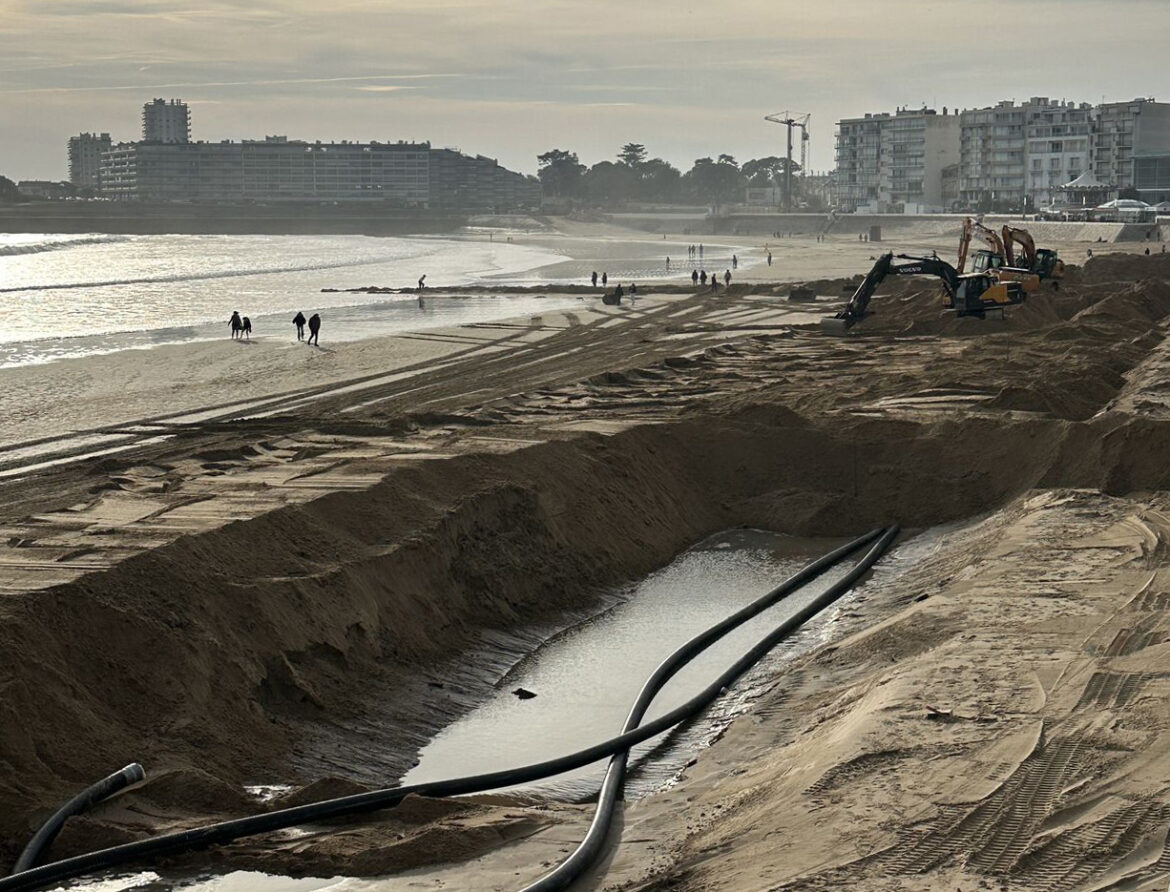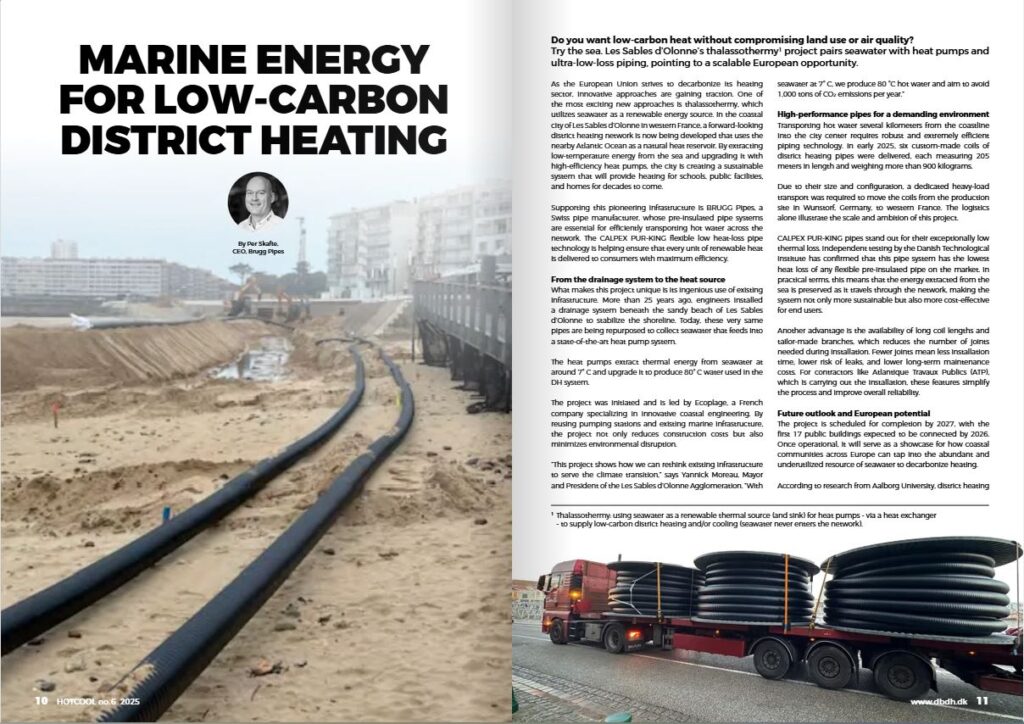Do you want low-carbon heat without compromising land use or air quality? Try the sea. Les Sables d’Olonne’s thalassothermy project pairs seawater with heat pumps and ultra-low-loss piping, pointing to a scalable European opportunity.
By Per Skafte, CEO, Brugg Pipes
Published in Hot Cool, edition no. 6/2025 | ISSN 0904 9681 |
As the European Union strives to decarbonize its heating sector, innovative approaches are gaining traction. One of the most exciting new approaches is thalassothermy, which utilizes seawater as a renewable energy source. In the coastal city of Les Sables d’Olonne in western France, a forward-looking district heating network is now being developed that uses the nearby Atlantic Ocean as a natural heat reservoir.
By extracting low-temperature energy from the sea and upgrading it with high-efficiency heat pumps, the city is creating a sustainable system that will provide heating for schools, public facilities, and homes for decades to come.
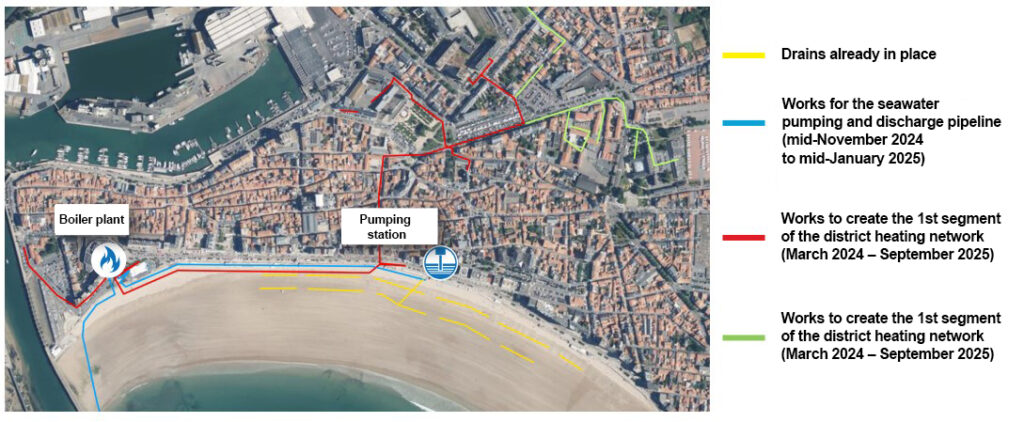
Supporting this pioneering infrastructure is BRUGG Pipes, a Swiss pipe manufacturer, whose pre-insulated pipe systems are essential for efficiently transporting hot water across the network. The CALPEX PUR-KING flexible low heat-loss pipe technology is helping ensure that every unit of renewable heat is delivered to consumers with maximum efficiency.
From the drainage system to the heat source
What makes this project unique is its ingenious use of existing infrastructure. More than 25 years ago, engineers installed a drainage system beneath the sandy beach of Les Sables d’Olonne to stabilize the shoreline. Today, these very same pipes are being repurposed to collect seawater that feeds into a state-of-the-art heat pump system.
The heat pumps extract thermal energy from seawater at around 7 °C and upgrade it to produce 80 °C water used in the DH system.
The project was initiated and is led by Ecoplage, a French company specializing in innovative coastal engineering. By reusing pumping stations and existing marine infrastructure, the project not only reduces construction costs but also minimizes environmental disruption.
“This project shows how we can rethink existing infrastructure to serve the climate transition,” says Yannick Moreau, Mayor and President of the Les Sables d’Olonne Agglomeration. “With seawater at 7 °C, we produce 80 °C hot water and aim to avoid 1,000 tons of CO₂ emissions per year.”
High-performance pipes for a demanding environment
Transporting hot water several kilometers from the coastline into the city center requires robust and extremely efficient piping technology. In early 2025, six custom-made coils of district heating pipes were delivered, each measuring 205 meters in length and weighing more than 900 kilograms.
Due to their size and configuration, a dedicated heavy-load transport was required to move the coils from the production site in Wunstorf, Germany, to western France. The logistics alone illustrate the scale and ambition of this project.
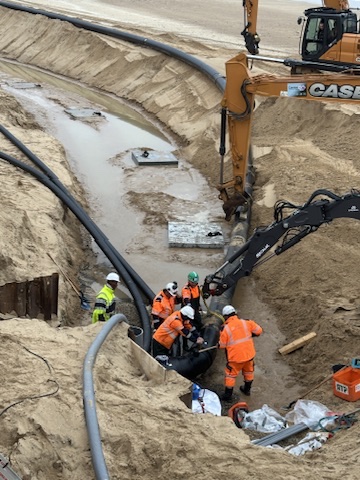
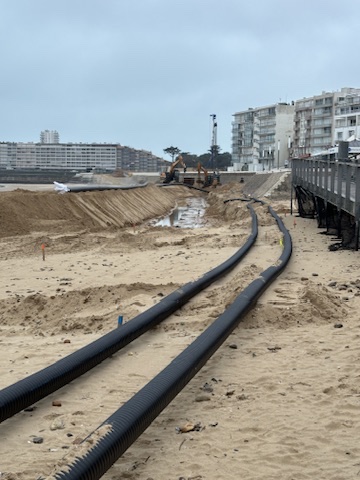
CALPEX PUR-KING pipes stand out for their exceptionally low thermal loss. Independent testing by the Danish Technological Institute has confirmed that this pipe system has the lowest heat loss of any flexible pre-insulated pipe on the market. In practical terms, this means that the energy extracted from the sea is preserved as it travels through the network, making the system not only more sustainable but also more cost-effective for end users.
Another advantage is the availability of long coil lengths and tailor-made branches, which reduces the number of joints needed during installation. Fewer joints mean less installation time, lower risk of leaks, and lower long-term maintenance costs. For contractors like Atlantique Travaux Publics (ATP), which is carrying out the installation, these features simplify the process and improve overall reliability.
Future outlook and European potential
The project is scheduled for completion by 2027, with the first 17 public buildings expected to be connected by 2026. Once operational, it will serve as a showcase for how coastal communities across Europe can tap into the abundant and underutilized resource of seawater to decarbonize heating.
According to research from Aalborg University, district heating could supply up to 48% of the EU’s heating demand by 2050 if renewable and low-carbon sources are integrated more widely. While biomass, geothermal, and industrial waste heat are often discussed, seawater remains a largely untapped resource, despite the fact that Europe has over 85,000 kilometers of coastline.
A study by the German Heat Pump Association found that if lakes, rivers, and seas were systematically harnessed for thermal energy, emissions could be reduced by more than 8 million tons of CO₂ annually. This suggests that the potential of projects like Les Sables d’Olonne is far from marginal – it could be transformative.
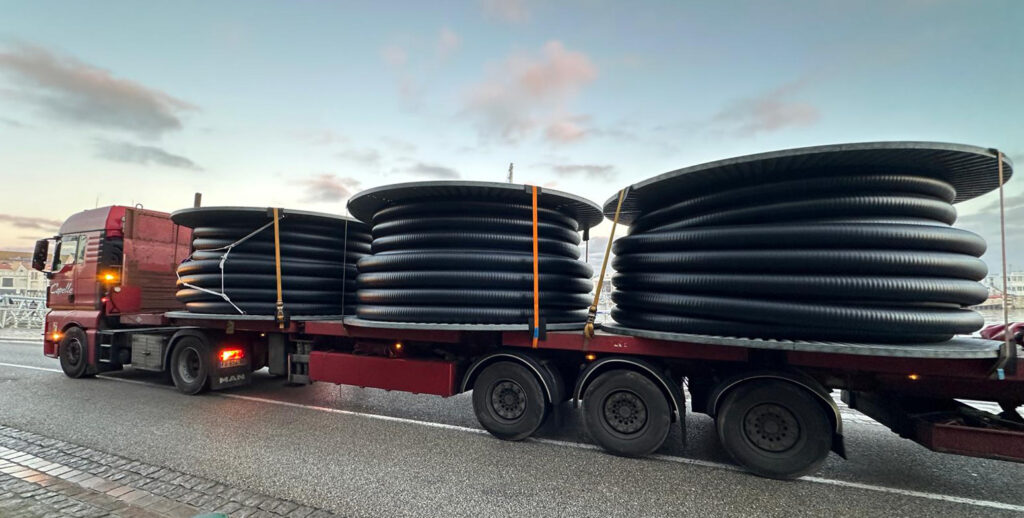
Why seawater?
Unlike fossil fuels, seawater is renewable, abundant, and free. It provides a stable year-round temperature source, which makes it well-suited for heat pump applications. Unlike solar or wind, it is not dependent on daily or seasonal fluctuations in the same way, offering greater predictability.
In addition, using seawater avoids the air quality concerns often associated with biomass combustion, and it requires less land than solar thermal or ground-source systems. For coastal communities, it represents a logical and sustainable extension of the natural environment.
Of course, seawater systems require careful design to avoid ecological impacts, such as the safe return of cooled water to the sea. In the Les Sables d’Olonne case, environmental safeguards are in place, and the reuse of existing infrastructure reduces new marine disturbances.
Overcoming challenges
Despite its potential, regulations often fail to recognize seawater as a viable renewable source. This creates barriers to project development, even when technical feasibility is proven.
Financing can also be a challenge. Large upfront investments are needed for pumps, pipes, and grid connections. However, once established, operational costs are relatively low, especially when paired with highly efficient technologies. Public funding, loan guarantees, and EU-level support could accelerate the replication of this approach across Europe.
Local impact
Beyond carbon savings, the project has direct benefits for the local community. Heating public buildings with renewable energy strengthens energy security, reduces exposure to volatile fossil fuel prices, and creates local jobs during construction and operation.
Symbolically, it also connects the community more closely with the sea, transforming what was once seen as a threat, erosion and rising waters, into part of the solution to climate change. For Les Sables d’Olonne, the project is both a technical achievement and a cultural milestone.
Conclusion
The Les Sables d’Olonne project is more than just another district heating network. It is a proof of concept for how marine energy can play a central role in Europe’s heating transition. By combining innovative engineering, efficient infrastructure, and strong local leadership, the project demonstrates that the future of heating can be renewable, local, and resilient.
As the EU moves toward climate neutrality by 2050, scaling up solutions like thalassothermy will be essential. With pioneering suppliers like BRUGG Pipes and visionary local partners like Ecoplage, Europe’s coastal cities are showing that the oceans themselves may hold the key to a sustainable heat transition.
For further information, please contact: Per Skafte at per.skafte@brugg.com
“Marine Energy for Low-Carbon District Heating” was published in Hot Cool, edition no. 6/2025. You can download the article here:
Did you find this article useful?
Subscribe to the HOT|COOL newsletters for free and get insightful articles on a variety of topics delivered to your inbox twice a month!
